Archive for the 'Board Game Review' Category
Posted by James (admin) on 6th May 2015
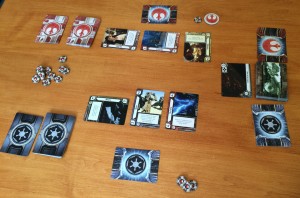 Star Wars: Empire vs Rebellion is a 2-player card game which uses the core game mechanics of Cold War: CIA v KGB with some changes and a Star Wars theme. (As Cold War: CIA v KGB is one of my favourite 2-player games, there are lots of comparisons to be made, but I shall save these until the end of the review so those who have
Star Wars: Empire vs Rebellion is a 2-player card game which uses the core game mechanics of Cold War: CIA v KGB with some changes and a Star Wars theme. (As Cold War: CIA v KGB is one of my favourite 2-player games, there are lots of comparisons to be made, but I shall save these until the end of the review so those who have
not played Cold War can understand this game on its own merits.)
At the start of each round, an objective card is drawn which sets several things: the total resource value, the capacity, and its objective value (plus, some have special rules for the round too). Each round, players take turns drawing or manipulating resource cards from their own resource deck (Empire or Rebellion). Each resource card has a number on it (usually 2 to 5) as well as a special power, and players can never have more resource cards than the objective’s capacity. The round ends only when both players pass in succession, and which player won the round is assessed. Usually, the player with the cards whose total value is closest to the the objective’s total resource value (without going over) is the winner of the round – there are some occasions when this is different but I’ll explain that later. The winner takes the objective card (as well as any resource tokens it grants) and the first player to have objective cards whose total objective value is 7 or more wins the game. Read the rest of this entry »
Tags: board game news, Board Games, board gaming, FFG, Star Wars: Empire vs Rebellion
Posted in Board Game Review, Board Games, Star Wars: Empire vs Rebellion | No Comments »
Posted by James (admin) on 5th May 2015
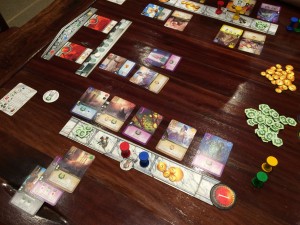 Elysium is Greek god themed game played over 5 rounds and the player with the most victory points (VPs) is the winner. Each round, players take turns taking either one of the god cards available that round or a turn order marker until they have had 4 turns. Each of the god cards gives its owner a benefit or ability – some abilities can be used once during the whole game, some are permanent abilities, some get used once per round, etc. When the cards are gained, they are placed in your ‘Domain’ – the area above your player board – these can be used for their abilities, but do not count towards scoring. During the game, you can move cards from your Domain to your ‘Elysium’ – the area below your player board – only in your Elysium do cards count towards scoring at the end of the game, but they can no longer be used for their abilities.
Elysium is Greek god themed game played over 5 rounds and the player with the most victory points (VPs) is the winner. Each round, players take turns taking either one of the god cards available that round or a turn order marker until they have had 4 turns. Each of the god cards gives its owner a benefit or ability – some abilities can be used once during the whole game, some are permanent abilities, some get used once per round, etc. When the cards are gained, they are placed in your ‘Domain’ – the area above your player board – these can be used for their abilities, but do not count towards scoring. During the game, you can move cards from your Domain to your ‘Elysium’ – the area below your player board – only in your Elysium do cards count towards scoring at the end of the game, but they can no longer be used for their abilities.
There are 8 sets of god cards in the game – each is a different colour and represents a specific god. Whilst the cards within each set have lots of variety, the abilities of each set of god cards have a common theme; for example, one god’s cards are about affecting other players, etc. Each game is played with 5 of the 8 sets, so this will give variety in replay, especially as 2 of the sets add extra rules too. Also, as well as the set (god/colour) it belongs to, each god card has the number 1, 2, or 3 on it too. The majority of VPs usually come from sets of god cards in your Elysium – either sets of the same colour but different number, or same number but different colour. Read the rest of this entry »
Tags: board game news, Board Games, board gaming, Elysium, Space Cowboys
Posted in Board Game Review, Board Games, Elysium | 2 Comments »
Posted by James (admin) on 25th March 2015
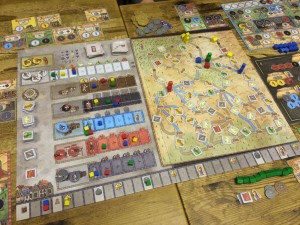
The main board with the different character tracks on the left, the roads/rivers/cities where players move and build trading posts on the right, and development track across the bottom.
Orléans is from dlp games who released the highly-entertaining game Citrus last year. Orléans combines multiple game mechanics such as bag-building, meeple movement, and worker placement.
Each player has a bag of character tokens (farmers, knights, craftsmen, etc.) and players will add more tokens to their bag during the game. At the start of each round, players draw some characters from their bag, and each player places them on their player boards in specific combinations to activate actions. Most actions require 2 or 3 characters to activate them so there are often tricky choices deciding in which combinations to allocate the drawn characters each turn. Players can part-fill actions and complete them on a later turn too.
There are lots of different actions to choose from. Many add a character to your bag and then advance you along the matching track on the central game board which give a benefit – the further along a track you are, the better the benefit. For example, adding a boatman to your bag advances you along the boatman track which earns you coins. Adding a knight to your bag also advances you along the knight track which allows you to draw more characters at the start of each round. Adding a trader to your bag allows you to take one of the building tiles and you can use the special action on it from then onwards – some special actions are cheaper versions of the main actions, but most are special abilities such as creating goods, or using a boatman character as a craftsman/farmer/trader instead. Read the rest of this entry »
Tags: board game news, Board Games, board gaming, dlp games, Essen, Orléans, Spiel 14, Spiel 2014
Posted in Board Game Review, Board Games, Essen Spiel 14, Orléans, Spiel 2014 | No Comments »
Posted by James (admin) on 24th March 2015
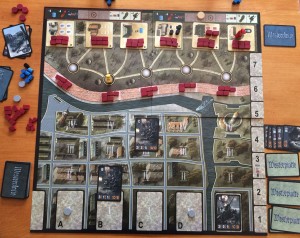
The players move around and defend the North of the board from the Germans who advance from the South.
7 Days of Westerplatte is a co-operative game about the opening shots of World War II, when a German ship began bombarding the Polish, with German troops soon following. During the game, players take on the role of the Polish in trying to last out 7 days. The game is relatively simple. Players take turns carrying out their turn and, once a player has completed their actions, the German forces take their actions.
On their turn, a player can move their troop figure up to 2 spaces and take 1 action, in any order. As an action, a player on one of the 6 building tiles can use the building’s power to do things such as gaining ammo, planting a land mine for the enemy to trip, fire a mortar (doing 2 damage to an enemy anywhere on the board), move some enemy units backwards, raise morale, or add 2 bricks to one area. (The mortars, mines and bricks are limited in number.) Alternatively, a player on one of the 5 spaces near the river can use their action to spend 1 ammunition to inflict 1 damage on an enemy troop, if there is one in the same column as the player. If other players are on the space, they can combine fire and also each spend 1 ammunition each to inflict 1 damage each too – this is very handy as tougher enemies appear. Read the rest of this entry »
Tags: 7 Days of Westerplatte, board game news, Board Games, board gaming, G3
Posted in 7 Days of Westerplatte, Board Game Review, Board Games | No Comments »
Posted by James (admin) on 30th January 2015
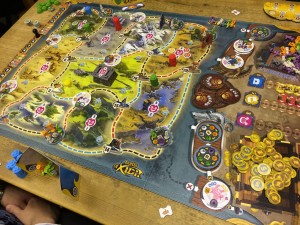 Lords of Xidit is a medium-weight eurogame whose core mechanic is about programming your moves and actions which results in a mix of short-term decision-making with some longer-term strategies. This allows you to recover if you mess up, or if someone gets in your way (intentionally or by outsmarting you).
Lords of Xidit is a medium-weight eurogame whose core mechanic is about programming your moves and actions which results in a mix of short-term decision-making with some longer-term strategies. This allows you to recover if you mess up, or if someone gets in your way (intentionally or by outsmarting you).
The Game
Players move their character around the land from city to city, recruiting units and defeating threats. At the start of each round, each player programs 6 actions that their character will perform in sequence. There are 5 actions to choose from: move along either the red, white, or blue road from their current city, interact with the city where they are located, or wait. You need to work out which actions you want to perform and where but, as with other action-programming games, you need to work out what your opponents will be trying to do too.
Interacting at a city with a recruitment disc lets you takes the least valuable unit from the disc (the more valuable ones are more rare). Interacting at a city with a threat disc lets you defeat the treat if you discard the required unit types shown in the disc. Successfully defeating a threat lets you pick one of the 3 reward types: gold, bard tokens, or tower sections. Bard tokens are placed in the city’s neighbouring areas which adds an element of area control to the game. Tower sections get placed in a stack at the city but no other player can have a tower in a city if an opponent has one there already. Read the rest of this entry »
Tags: Asmodee, board game news, Board Games, board gaming, Essen, Libellud, Lords of Xidit, Spiel 14, Spiel 2014
Posted in Board Game Review, Board Games, Essen Spiel 14, Lords of Xidit, Spiel 2014 | 1 Comment »
Posted by James (admin) on 3rd September 2014
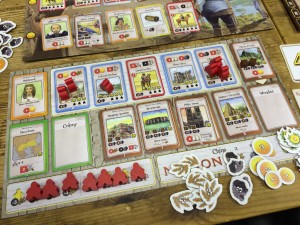
A player’s board showing their card slots.
The first thing that strikes you about Nations is that it’s a civilisation game without a geographic board. Instead, Nations’ more abstracted approach to a civ-themed game delivers a very tight, and different, game for gamers.
Each player has a board showing a limited number of ‘slots’ where cards can be placed. Each slot is colour-coded to show which type(s) of cards (Buildings/Military, Advisor, Colony, and Wonders) can be placed there. There are also two central boards: The progress board (showing the cards available for purchase this round where the row dictates the cost) and the main game board (showing the players’ military strength/stability/total books, plus events, available architects, etc.)
During the game, players take turns to either: Buy 1 card, Deploy 1 worker, or Hire 1 architect to build a wonder. A purchased card must be immediately placed on your player board on a matching coloured slot – building over an existing card if necessary. This adds tension to the game because, not only do you need to figure out which cards will work well with your existing cards, but you need to consider what cards your opponents will be aiming for too. Also, the limited number of slots really makes you think about how to achieve lots with relatively little. (Note that Blue and Red cards share the same slots so more military means fewer buildings and vice versa.) Read the rest of this entry »
Tags: board game news, Board Games, board gaming, Essen, Lautapelit.fi, Nations, Spiel 13, Spiel 2013
Posted in Board Game Review, Board Games, Essen Spiel 13, Nations, Spiel 2013 | No Comments »
Posted by James (admin) on 28th August 2014
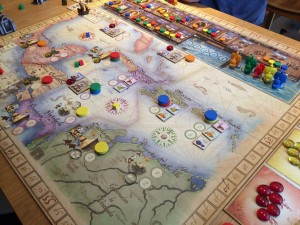 Francis Drake was one of my favourite games at Spiel 2013. A game of sailing, looting and plundering, but with strong eurogame mechanics and some psychological interplay between the players.
Francis Drake was one of my favourite games at Spiel 2013. A game of sailing, looting and plundering, but with strong eurogame mechanics and some psychological interplay between the players.
During the game, players will set sail 3 times and each voyage consists of a provisioning phase and a sailing phase. The provisioning phase is where the players gather resources for their journey: guns, crew, supplies, trade goods, a bigger ship, special roles, etc. Players take turns moving along the main street of Plymouth – 18 locations laid out in a long line – and the players take turns using a location by placing one of their 10 action discs to gain whatever the location offers. However, players can only select locations further down the street from their last location (and never go backwards). Also, some locations have limited slots/uses, plus some of the actions on a location are better than others. As a result, players want to progress slowly to use lots of different locations, but move quickly so they can grab what is on offer before someone else does (and they are potentially left without a resource they want). If you’ve played Egizia (one of my favourite games), you’ll recognise this very engaging game mechanic. Read the rest of this entry »
Tags: board game news, Board Games, board gaming, Eagle Games, Essen, Francis Drake, Spiel 13, Spiel 2013
Posted in Board Game Review, Board Games, Essen Spiel 13, Francis Drake, Spiel 2013 | No Comments »
Posted by James (admin) on 1st August 2014
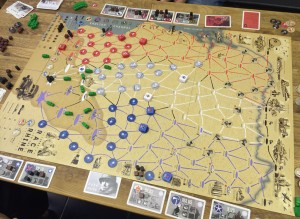 Race to the Rhine is a game for up to 3 players who each play a WWII Allied General. You may be on the same side of the war but this is not a co-operative game – first player over the Rhine, or the player with the most medals if time runs out, wins. As you’re on the same side, there’s no combat against each other but you are in competition for the central supplies and you can place enemy forces to hinder your opponents.
Race to the Rhine is a game for up to 3 players who each play a WWII Allied General. You may be on the same side of the war but this is not a co-operative game – first player over the Rhine, or the player with the most medals if time runs out, wins. As you’re on the same side, there’s no combat against each other but you are in competition for the central supplies and you can place enemy forces to hinder your opponents.
THE GAME
Race to the Rhine is about planning and logistics as you need to keep your Corps supplied with Ammo, Fuel and Food which requires careful timing of your actions. Players take turns performing two actions: Move Corps, Gain Supplies, Gain Trucks, Place Trucks (moves supplies), Recon, and Airborne Units.
Movement & Combat
Each player moves their units (Corps) towards the Rhine via a network of roads; however, each player stays within their coloured section which occasionally overlap. A Move action moves one Corps up to 3 locations (costing 1 fuel) drawing a card when entering each empty location to see what happens. You normally draw from your own deck (mostly beneficial with a few negative cards). If the location contains an Axis marker, you draw from the Axis deck (tough enemy). If you successfully enter a location, you place one of your control markers there. Combat against Axis forces requires spending various amounts of ammo and sometimes fuel; otherwise, you lose the combat, spend what you can, but don’t enter the location. Read the rest of this entry »
Tags: board game news, Board Games, board gaming, Phalanx, Race to the Rhine
Posted in Board Game Review, Board Games, Race to the Rhine | No Comments »
Posted by James (admin) on 16th July 2014
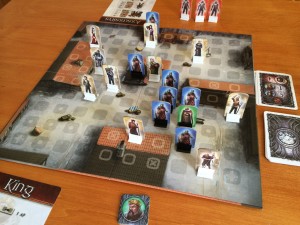 King and Assassins is an asymmetric, 2-player game where the King player controls the king and his knights; whereas, the Assassin player controls the villagers in the town of which 3 are assassins who are trying to kill the king.
King and Assassins is an asymmetric, 2-player game where the King player controls the king and his knights; whereas, the Assassin player controls the villagers in the town of which 3 are assassins who are trying to kill the king.
The rules are simple. Each player has a number of action points (APs) to spend on their turn which can be used to move their figures, make attacks, etc. Each turn, a card is drawn which determines how many APs the King player can spend (there are separate amounts for the king and to be spent amongst the knights), plus it shows if a knight can arrest 1 villager that turn (permanently removing it). Also, each card shows how many APs the Assassin player can spend on their villagers/assassins too. If the cards run out or the king is killed (wounded twice) before reaching the castle, the Assassin player wins. Read the rest of this entry »
Tags: board game news, Board Games, board gaming, Essen, King and Assassins, Spiel 13, Spiel 2013
Posted in Board Game Review, Board Games, Essen Spiel 13, King and Assassins, Spiel 2013 | No Comments »
Posted by James (admin) on 12th June 2014
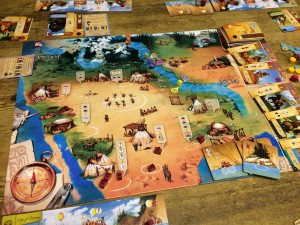 Lewis & Clark is a game about the famous explorers’ journey across North America and the players race along the route from St Louis to Fort Clatsop (on the Pacific coast) which is a sequence of river and mountain spaces. The winner is the first player to make camp at Fort Clatsop.
Lewis & Clark is a game about the famous explorers’ journey across North America and the players race along the route from St Louis to Fort Clatsop (on the Pacific coast) which is a sequence of river and mountain spaces. The winner is the first player to make camp at Fort Clatsop.
Players have characters (cards) and Indians (meeple) which they use to take actions which earn resources and, ultimately, advance their scout. Each player starts with a board showing several boats (and they can gain more) which is where they store their resources and Indians. The boats limit how much a player can carry but they have another important role/effect too when it comes to making camp.
Making Camp
On their turn, a player can ‘make camp’ which moves their camp marker to where their scout is, plus they pick-up all their played cards back into their hand. However, before placing the camp marker, the scout must first move backwards a number of spaces based on how many unplayed cards the player has, plus the resources/Indians in their boats. Each boat specifically carries resources or Indians – some carry items without penalty, some have a flat rate cost regardless of contents, and some have a penalty for every item in the boat. Read the rest of this entry »
Tags: board game news, Board Games, board gaming, Essen, Lewis & Clark, Lewis and Clark, Ludonaute, Spiel 13, Spiel 2013
Posted in Board Game Review, Board Games, Essen Spiel 13, Lewis and Clark, Spiel 2013 | 6 Comments »
 Star Wars: Empire vs Rebellion is a 2-player card game which uses the core game mechanics of Cold War: CIA v KGB with some changes and a Star Wars theme. (As Cold War: CIA v KGB is one of my favourite 2-player games, there are lots of comparisons to be made, but I shall save these until the end of the review so those who have
Star Wars: Empire vs Rebellion is a 2-player card game which uses the core game mechanics of Cold War: CIA v KGB with some changes and a Star Wars theme. (As Cold War: CIA v KGB is one of my favourite 2-player games, there are lots of comparisons to be made, but I shall save these until the end of the review so those who have









 Lewis & Clark is a game about the famous explorers’ journey across North America and the players race along the route from St Louis to Fort Clatsop (on the Pacific coast) which is a sequence of river and mountain spaces. The winner is the first player to make camp at Fort Clatsop.
Lewis & Clark is a game about the famous explorers’ journey across North America and the players race along the route from St Louis to Fort Clatsop (on the Pacific coast) which is a sequence of river and mountain spaces. The winner is the first player to make camp at Fort Clatsop.